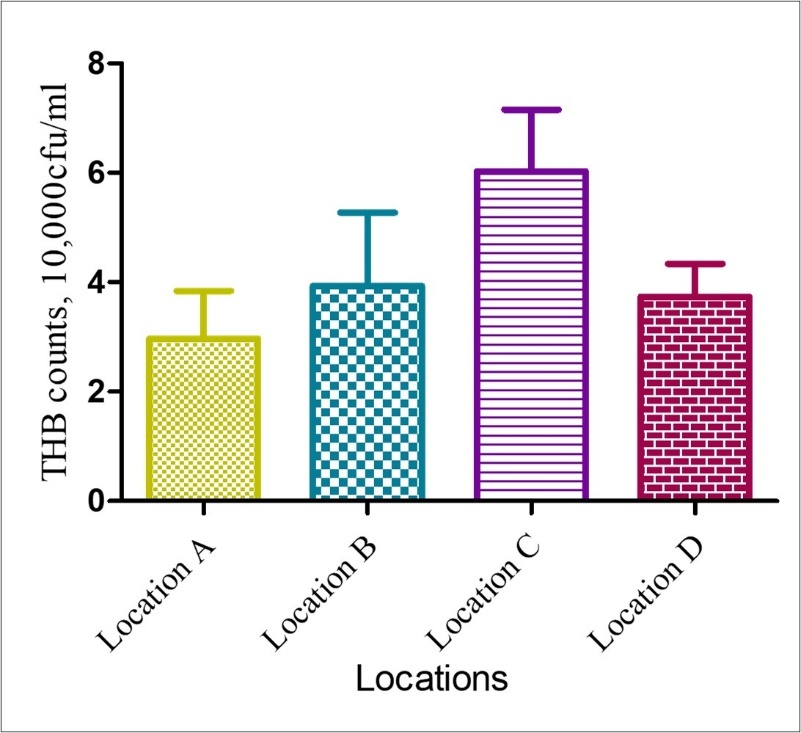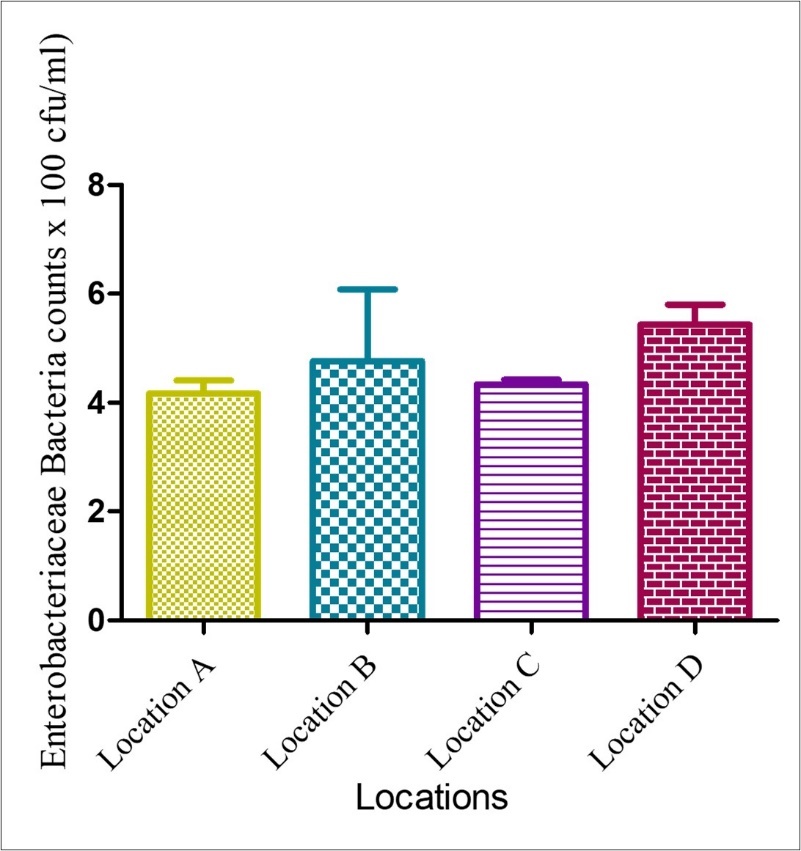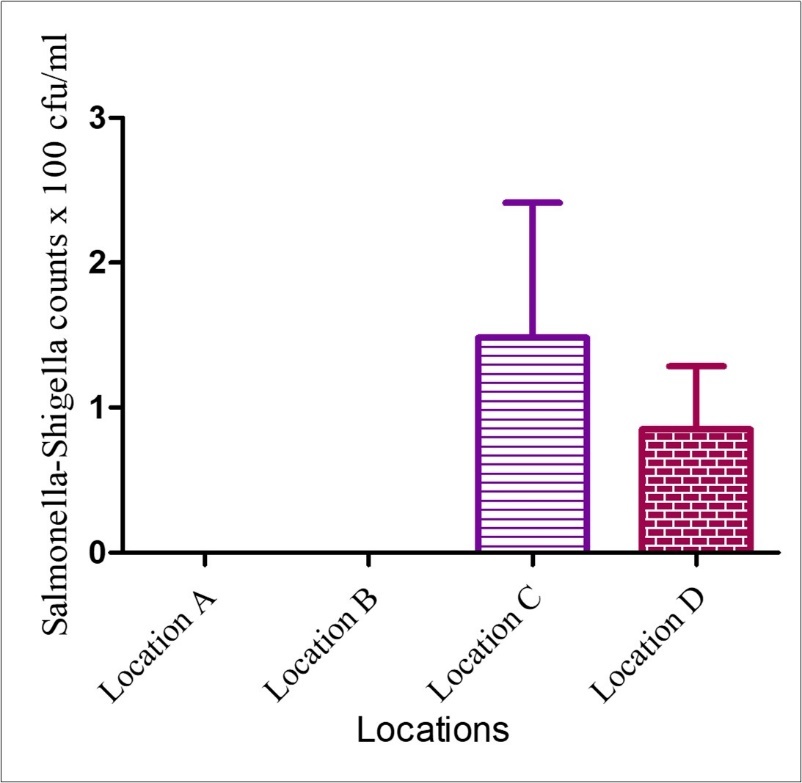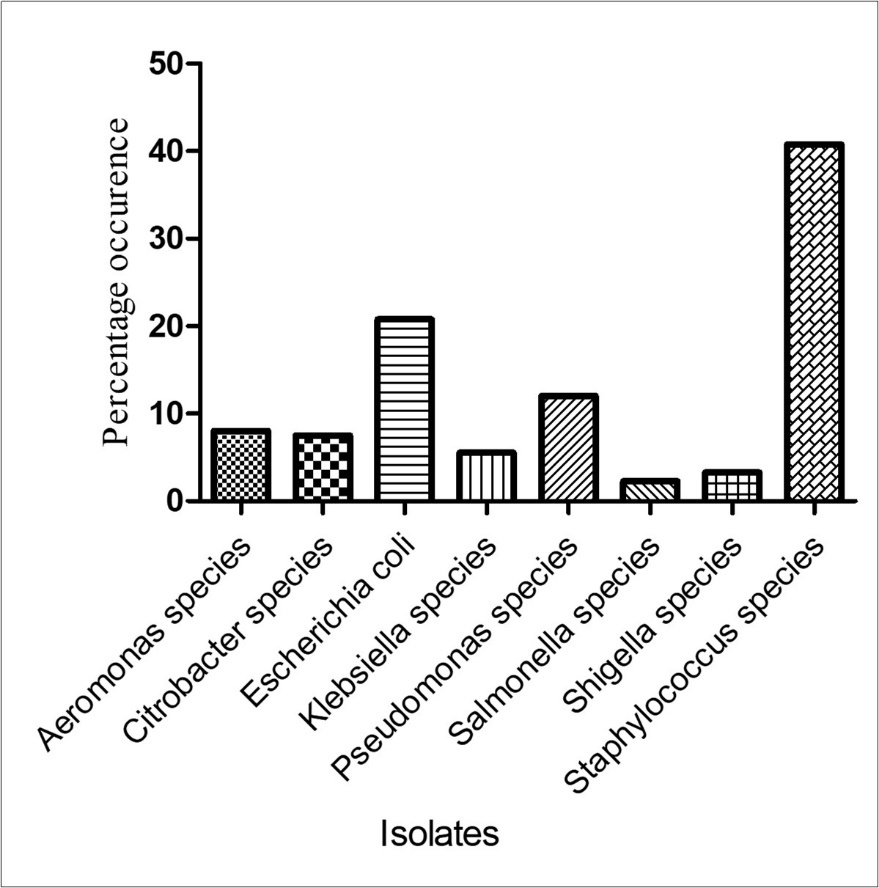Bacteriological Quality of Groundwater in Imiringi Town, Bayelsa State, Nigeria
Abstract
This study evaluated the bacteriological quality of groundwater from Imiringi in Ogbia Local government area of Bayelsa State, Nigeria. Groundwater samples were obtained in triplicates from four locations in the study area and analyzed for the bacteria quality using standard protocols. Results showed that the microbial density ranged from 2.97 – 6.03 x 104 cfu/ml (for total heterotrophic bacteria counts), 4.17 – 5.43 x 102 cfu/ml (for Enterobacteriaceae bacteria counts) and 0.00 – 1.48 x 102 cfu/ml (for Salmonella-Shigella counts). Statistically, there was no significant difference (p>0.05) across the various locations for each of the parameters. The density observed were higher than the allowable limit of 1.0 x 102 cfu/ml for drinking water as recommended by World Health Organization/Food and Agricultural Organization, and maximum permissible level of 10cfu/ml for total coliform as specified by Standard Organization of Nigeria. The prevalence of bacteria isolated in the water samples were Aeromonas species (8.00%), Citrobacter species (7.50%), Escherichiacoli (20.75%), Klebsiella species (5.50%), Pseudomonas species (12.00%), Salmonella species (2.25%), Shigella species (3.25%) and Staphylococcus species (40.75%). From the bacteria density and diversity, the water is not potable. Some of the bacterial found are of public health importance. Hence, there is a need to adequately treat the water using chlorination and boiling techniques before drinking.
Author Contributions
Academic Editor: Jun Wan, Department of Medical and Molecular Genetics, Indiana University School of Medicine, USA.
Checked for plagiarism: Yes
Review by: Single-blind
Copyright © 2020 Enetimi Idah Seiyaboh, et al.
 This is an open-access article distributed under the terms of the Creative Commons Attribution License, which permits unrestricted use, distribution, and reproduction in any medium, provided the original author and source are credited.
This is an open-access article distributed under the terms of the Creative Commons Attribution License, which permits unrestricted use, distribution, and reproduction in any medium, provided the original author and source are credited.
Competing interests
The authors have declared that no competing interests exist.
Citation:
Introduction
Naturally, microorganisms are ubiquitous and they are found everywhere including the human body and environmental components (such as air, soil, water and sediments). Many microbes are harmful while some others are beneficial to humans. Many diseases that have caused a pandemic in human history were caused by microbes. Some of the disease-causing microorganisms are closely associated with humans and other warm-blooded animals such as mammals and birds. These pathogens are transmitted from one organism to another by direct contact, ingestion of contaminated food and water among others. Some of them tend to produce toxins which could cause diseases within a few days to weeks on exposure.
Microbes in potable water often have detrimental activities on the body if not treated before consumption. Several microbes especially bacteria cause several water-borne diseases including cholera, typhoid fever, diarrhoea. Again, some bacteria in water serve as indicator organisms; their presence in water suggests contamination 1. The presence of total coliform, faecal coliform or faecal Streptococcus indicates that the water is contaminated by faecal material, but these bacteria types do not exist solely in the faeces of warm-blooded animals. For instance, Escherichia coli in potable water come from several sources including septic tank systems failure, improper septic system construction or design, municipal sludge and sewage. Besides, total coliform and faecal coliform are also present in some soils possibly from faecal matters in the environment that might have emanated from domestic animals roaming around the homestead and even human activities.
Some common bacteria found in water that affect human health include Escherichia coli (which are often characterized by nausea, vomiting, abdominal pain and diarrhoea), Campylobacter jejuni (that is characterized by several symptoms including cramping, diarrhoea, fever and pain), and Salmonella species (some strains cause chills, fever, headache, diarrhoea, and pain). These bacterial show symptoms at different days’ interval after exposure.
In Nigeria, Izah and Ineyougha 1 reported that the drinking water sources are often contaminated by Staphylococcus aureus, Escherichia coli, Proteus, Pseudomonas, Enterobacter, Salmonella, Klebsiella, Bacillus species etc to a large extent and Alcaligenes faecalis, Aeromonas, Micrococcus, Citrobacter, Streptococcus, Vibrio, Shigella, Enterococcus, Flavobacterium, Chromobacterium, Clostridium perfringens, Phaerotilus, Erwinia and Yersinia species etc to a lesser extent. Also, Curvularia, Penicillium, Rhizopus, Fusarium, Mucor, Cladosporium, Saccharomyces, Mortierella and Aspergillus species have been reported in surface water (one of the drinking water sources) in Nigeria 1, 2. The microbial counts often determined in potable water sources include total heterotrophic bacteria counts, total enteric counts (including coliforms, Salmonella-shigella counts and Vibrio) and total fungal counts.
The problem of microbial contamination of potable water has become a rising issue in so many regions especially in developing countries. Most people in rural areas where the illiteracy level is high believes that borehole water is safe from contamination and is potable for consumption without knowing that the aquifer can be contaminated as a result of leakage in pipes and tanks. Sometimes, leakage from the septic tank could end up in the groundwater especially during the wet season that water table is expected to rise especially in Bayelsa state, Nigeria. Some of these bacteria found in drinking water can lead to so many illness and even death, therefore drinking quality water is as important as eating good food. Hence, this study focused on the bacteriological characteristics of groundwater resources in Imiringi town, Bayelsa State, Nigeria.
Materials and Methods
Study Area
The geographical location of this study is Imiringi community situated in Ogbia local government area of Bayelsa State in the Niger Delta region of Nigeria. Imiringi is located between longitude E60 022’ and latitude N40 053’ 3. The community hosts several oil and gas facilities which have been in existence for over 30 years. Natural gas is flared into the environment in the area. Like other areas in the Niger Delta region, two predominant seasons occur in the study area viz: wet and dry seasons.
Collection of the Water Samples
The samples were collected in sterile universal containers by opening the bottles under sterile conditions. The sample containers were covered, labelled appropriately and transported to the laboratory immediately for analysis.
Microbial Density Determination
Nutrient Agar, MacConkey agar and Salmonella-Shigella agar were used to enumerate total heterotrophic bacteria, Enterobacteriaceae bacteria and Salmonella-Shigella counts. The water samples were serially diluted and pour plate method previously described by Pepper and Gerba 4 and Benson 5 was employed to determine the bacterial population. Approximately 1.0ml of the diluted water samples was aseptically plated in the different media and incubated at 37ºC for 24- 48 hours. Then after, the colonies that grew on the different agar plates were counted and expressed as colony-forming units per millilitre of the water samples. The different colonies were isolated into nutrient agar plates for identification.
Identification of the Bacteria Isolated
The isolates that grew on different agar plates were characterized based on the biochemical tests previously described by Cheesbrough 6 and Benson 5. The resultant characteristics were compared with those of known taxa following the guide provided by Cheesbrough 6 and Bergey’s Manual of Determinative Bacteriology by Holt et al. 7. Besides, the black colonies suggest the presence of Salmonella species, while the pink colonies are indications of Shigella species 8, 9. The isolates were further streaked in Kligler iron agar, Thiosulphate citrate bile salt sucrose agar and Mannitol Salt Agar plates and the resultant characteristics were compared with the scheme of Cheesbrough 6.
Statistical Analysis
Graph pad prism 5 and SPSS software version 20 were used to carry out the statistical analysis of the bacteria population. One-way analysis of variance was carried out at P = 0.05, and Tukey Honestly Significance Difference (HSD) was used to determine the source of the observed differences were the number of observation is 3.
Results and Discussion
The bacteria density of groundwater from Imiringi in Bayelsa state, Nigeria is shown in Figures 1-3. In Locations A, B, C and D, the microbial density were ranged from 2.97±0.88 x 104 cfu/ml, 3.93±1.34 x 104 cfu/ml, 6.03±1.13 x 104 cfu/ml and 3.73±0.61 x 104 cfu/ml, respectively (for total heterotrophic bacteria counts) (Figure 1), 4.17 x 102 cfu/ml, 4.77±1.32 x 102 cfu/ml, 4.33±0.09 x 102 cfu/ml and 5.43±0.37 x 102 cfu/ml (for Enterobacteriaceae bacteria counts) (Figure 2) and 0.00±0.00cfu/ml, 0.00±0.00cfu/ml, 1.48±0.93 x 102 cfu/ml and 0.85±0.44 x 102 cfu/ml, respectively (for Salmonella-Shigella counts) (Figure 3). Statistically, there was no significant difference (p>0.05) across the various locations for each of the parameters (total heterotrophic bacteria, Enterobacteriaceae bacteria and Salmonella-Shigella counts). The absence of Salmonella-Shigella counts in Location A and B, suggests that the water is of better quality with respected to Salmonella and Shigella species when compared to Location C and D. The absence of significant variation is an indication of similar groundwater quality in the study area. The bacteria density in this study is higher than the World Health Organization/Food and Agricultural Organization allowable limit of 1.0 x 102 cfu/ml in drinking water 1, 10, 11, 12 and Standard Organization of Nigeria maximum permissible level of 10 cfu/ml for total coliform in potable water 1, 13. This is an indication that the water is not fit for human consumption without treatment for bacterial quality. The bacterial in the study would have been in the tank used for water storage before being taken for domestic use.
Figure 1.Total Heterotrophic Bacteria counts in groundwater from Imiringi in Bayelsa state, Nigeria
Figure 2.Enterobacteriaceae Bacteria counts in groundwater from Imiringi in Bayelsa state, Nigeria
Figure 3.Salmonella-Shigella counts in groundwater from Imiringi in Bayelsa state, Nigeria
Figure 4 shows the frequency of occurrence of bacteria isolated from the water samples from the study area. The prevalence of bacteria isolated in the water samples were Aeromonas species (8.00%), Citrobacter species (7.50%), Escherichiacoli (20.75%), Klebsiella species (5.50%), Pseudomonas species (12.00%), Salmonella species (2.25%), Shigella species (3.25%) and Staphylococcus species (40.75%). Staphylococcus species has the highest occurrence frequency, and this may be associated with handling processes before consumption. Staphylococcusaureus is a normal flora in human skin, therefore it may have entered the water due to human activities, while Salmonella species has the least occurrence frequency. The bacteria encountered in this study may have been introduced into the water due to human contact. Some of these isolates may have entered the groundwater through leakage of septic tanks and soakaway pits possibly due to the high water table in the area during the wet season (the season the study was conducted). The isolates found in this study have been previously detected in potable water sources in Nigeria 1. Some of the bacteria are of public health concern and have been linked to water-borne diseases such as diarrhoea. The occurrence of these bacteria isolates suggests that the water sources are not fit 14 for human consumption. For instance, Escherichia coli could cause intestinal disease characterized by diarrhoea, nosocomial pneumonia, dysentery and urinary tract infections 15, 16, and it’s associated with faecal materials. Some Shigella species causes Shigeollosis characterized by symptoms like diarrhoea, fever, and stomach cramps. Also, Salmonella species are enteric pathogens that cause enteric fever, intestinal diseases with symptoms like nausea, vomiting, fever and even death 16, 17. Some species of Staphylococcus such as Staphylococcus aureus produces toxins. The toxins may increase the severity of certain diseases such as food poisoning, septic and toxic shock syndrome, and the intensity depends on the individual susceptibility to the toxins 15, 16. Furthermore, some species of Pseudomonas such as Pseudomonas aeruginosa could cause bacteremia and septicemia. Klebsiella causes several diseases depending on the species. For instance, Klebsiella pneumoniae which causes urinary tract infection, pneumonia, intra-abdominal infection, bloodstream infection, meningitis, pyogenic liver abscess 18 and wound infections when it gets to susceptible sites in the human body. Klebsiella pneumoniae are often characterized by fevers and chills, rash, light-headedness, flu-like symptoms, cough and breathing issues. According to Antonara and Ardura 19, Citrobacter species are opportunistic pathogens that could lead to invasive diseases, such as infections of the urinary tract, respiratory tract, central nervous system, skin, and soft tissues in humans. The authors further reported that the bacteria could cause osteomyelitis, suppurative arthritis, bacteremia, endocarditis, endophthalmitis, and intra-abdominal infections, especially in neonates and immunocompromised individuals. Specifically, Citrobacter freundii and Citrobacter koseri are species that could cause urinary tract infections, and they can also be found in wounds and respiratory tracts 20, 21. Aeromonas species are a group of gram-negative bacteria that survive well in aquatic ecosystems. Aeromonas species causes enteric infection characterized by acute watery diarrhoea to dysenteric illness with symptoms like abdominal cramps, nausea, vomiting and fever 22. Other possible diseases caused by Aeromonas species include extraintestinal infections including septicemia, wound, urinary tract and ear infections. Of these 17 species of Aeromonas, only 3 is of clinical importance 23. Aeromonas species secrete enterotoxins which could cause illness in healthy as well as in immunocompromised individuals 23. According to Drancourt 22, Aeromonas caviae is the most prevalent species, and Aeromonas veronii could cause rare cholera-like illness and dysenteric diarrhoea in susceptible hosts.
Figure 4.The frequency of occurrence of bacteria isolated from the water samples
Conclusion
The essence of this study was to assess the different types of bacteria found in groundwater in Imiringi town, Bayelsa state. The study found that the total heterotrophic bacteria, Enterobacteriaceae and Salmonella-Shigella counts in the water samples exceeded the World Health Organization/Food and Agricultural Organization and Standard Organization of Nigeria standards. The isolates were mainly gram-negative except for Staphylococcus species. Many of the isolates were bacteria of clinical importance. The bacteriological contamination of the water can be prevented and controlled to keep the water safe for drinking and other domestic uses through boiling and chlorination. There is a need for regular cleaning and treatment of overhead storage tanks. The need to site the boreholes far from soakaway/ and or septic tanks cannot be emphasized due to high water table in Bayelsa state, Nigeria
References
- 1.Izah S C, Ineyougha E R. (2015) A review of the microbial quality of potable water sources in Nigeria. , Journal of Advances in Biological and Basic Research 1(1), 12-19.
- 2.Agbabiaka T O, Oyeyiola G P. (2012) Microbial and physicochemical assessment of Foma River. , Itanmo, Ilorin, Nigeria:, International Journal of Plant, Animal and Environmental Sciences 21(1), 209-216.
- 3.Uzoekwe S A. (2019) Impacts of Gas Flaring on the Fertility Status of Agricultural Soil in an Oil and Gas Host Community in the Niger Delta Region of Nigeria. , Annals of Ecology and Environmental Science 3(4), 14-19.
- 4.Pepper I L, Gerba C P.. (2005).Environmental microbiology.A laboratory manual. Second edition. Elsevier academic press
- 5.H J Benson. (2002) . Microbiological Applications: Laboratory Manual in General Microbiology/complete version, 5th , edition.McGaraw-Hill,New York .
- 6.Cheesbrough M.(2009).District Laboratory Practice in Tropical Countries.Low price Edition part2.CambridgePress,England.
- 7.Holt J G, Kneg N R, PHA Sneath, Stanley J T.. Williams ST (1994).Bergey’sManual of Determinative Bacteriology. William and Wilkins Publisher , Maryland. New York .
- 8.Odu N N, Adeniji A O. (2013) Microbiological analysis of some packed fruit juices sold in Port Harcourt Metropolis. , Nigeria, Nature and Science 11(4), 30-40.
- 9.Seiyaboh E I, Izah S C, Bokolo J E. (2017) Bacteriological quality of water from river nun at Amassoma Axises. , Niger Delta, Nigeria, ASIO Journal of Microbiology, Food Science & Biotechnological Innovations 3(1), 22-26.
- 10.Eze S O, Madumere I C. (2012) Physicochemical and microbiological analysis of Water bodies in Uturu, Abia state-Nigeria. , Asian Journal of Natural and Applied Sciences 1(4), 58-65.
- 11.Sunday J J, NCO Spencer, Kingsley O, Edet A O, Amaka D D. (2014) Physico-chemical and microbiological properties of water samples used for domestic purposes in Okada town, Edo state. , Nigeria, International Journal Current Microbiology and Applied Science 3(6), 886-894.
- 12.Oludare A, Sikiru S. (2012) Microbiological, physicochemical and mineral quality of borehole water in Ijebu land, Ogun state. , Nigeria.International Journal of Science and Advanced 2(1), 23-30.
- 13. (2007) Standard organization of Nigeria (SON). Nigerian Standard for Drinking Water Quality. Nigerian industrial standard. , Nigeria
- 14.Akubuenyi F C, Uttah E C, Enyi-Idoh K H. (2013) Microbiological and physicochemical assessment of major sources of water for domestic uses in Calabar Metropolis Cross River state. , Nigeria. Transnational Journal of Science and Technology 3(2), 31-44.
- 15.Odu N N, Imaku L N. (2013) Assessment of the Microbiological Quality of Street-vended Ready-To-Eat Bole (roasted plantain) Fish (TrachurusTrachurus) in Port Harcourt Metropolis. , Nigeria. Researcher,5(3): 9-18.
- 16.Ineyougha E R, Orutugu L A, Izah S C. (2015) Assessment of Microbial Quality of SmokedTrachurustrachurussold in some. , Markets of Three South-South States of Nigeria.International Journal of Food Research 2, 16-23.
- 17.Orutugu L A, Izah S C, Aseibai. (2015) Microbiological quality of Kunu drink sold in some major markets of Yenagoa Metropolis. , Nigeria, Continental Journal of Biomedical Science 9(1), 9-16.
- 18.Vading M, NaucleÂr P, Kalin M, Giske C G. (2018) Invasive infection caused by Klebsiella pneumoniae is a disease affecting patients with high comorbidity and associated with high long-term mortality. PLoS. , ONE 13(4), 0195258.
- 19.Antonara S, Ardura M I. (2018) Citrobacter Species. In Principles and Practice of Pediatric Infectious Diseases (Fifth Edition) 827-829.
- 20.Ranjan K P.Ranjan N (2013).Citrobacter: An emerging health care associated urinary pathogen. , Urol Ann 5(4), 313-314.
Cited by (29)
This article has been cited by 29 scholarly works according to:
Citing Articles:
Frontiers in Microbiology (2025) Crossref
Sylvester Chibueze Izah, M. Ogwu - Frontiers in Microbiology (2025) Semantic Scholar
Frontiers in Microbiology (2025) OpenAlex
Journal of Environmental Science and Health, Part C (2024) Crossref
J. C. Agbasi, A. L. Ezugwu, M. E. Omeka, I. Ucheana, C. Aralu et al. - Journal of environmental science and health. Part C, Toxicology and carcinogenesis (2024) Semantic Scholar
Journal of Environmental Science and Health Part C (2024) OpenAlex
(2024) Crossref
(2024) Crossref
Food Science and Biotechnology (2024) Crossref
(2024) Crossref
(2024) OpenAlex
Elsevier eBooks (2023) OpenAlex
Elsevier eBooks (2023) OpenAlex
Food Science and Biotechnology (2023) OpenAlex
Kurotimipa Frank Ovuru, Sylvester Chibueze Izah, O. Ogidi, O. Imarhiagbe, M. Ogwu - Food Science and Biotechnology (2023) Semantic Scholar
Elsevier eBooks (2023) OpenAlex
Ime Michael Umana, P. Neji, J. A. Agwupuye - Applied Water Science (2022) Semantic Scholar
International Journal of Pathogen Research (2022) OpenAlex
Sustainable development and biodiversity (2022) OpenAlex
Glory Richard, E. R. Aseibai - Sumerianz journal of medical and healthcare (2021) Semantic Scholar
